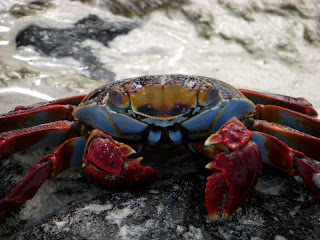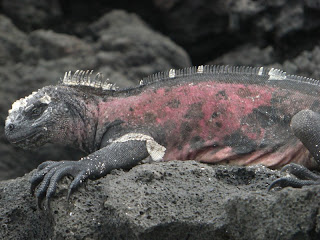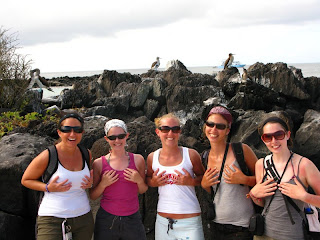Galapagos Islands: Origin of Species
Jess here, straight from Ecuador!
A week ago Friday, Jodi, Phil and I left Guayaquil and flew to the Galapagos (Isla Baltra). The Galapagos Islands are named for the saddle-backed Galapagos tortoises, and are located in the Pacific Ocean 604 miles off the coast of Ecuador. The oldest island is thought to have formed between 5 and 10 million years ago. The youngest islands, Isabela and Fernandina, are still being formed, with the most recent volcanic eruption having occurred last week. The islands, discovered by Europeans in the early 1500s, were originally used by English pirates to steal treasure from the Spaniards, and it wasn’t until the early 19th century that it was used as a base for whalers In 1835, the HMS Beagle made its expedition to the Galapagos for a study of geology and biology, and well…. the rest is an evolution revolution.
We met up with our boat, the Friendship, for what we thought was going to be a 5-day/4- night cruise. We had read mixed reviews of our boat, and it turned out to be just as we all expected…. A mixed bag of great people and shabby accommodations (we basically got what we paid for). The people on our boat were also a mixed crew…. The 3 of us (2 Americans and 1 Canadian, for those of you who cant remember us since we have been gone so long), 1 other American, 1 Dutchman, 2 Israelis, 1 Brit, 1 Chinese, 1 Brazilian and 6 Ecuadorians. A United Nations of sorts, all bonding together to enjoy all the beauty and wildlife the Galapagos has to offer.
Our not-so-safe boat’s group on the beach.
That afternoon, we met our tour guide (Fabian) and the rest of the crew. As a side note, we ended up really liking Fabian, especially his pronunciation of most words, such as Galapagos (pronounced by him as Gaal-AAAAA-pagos). Anyway, we left the boat via our dingy (sans life-jackets, all part of the tourist boat adventure) and out to Playa Bachas to see some wildlife. We were greeted by crabs and pelicans and marine iguanas.
Later that afternoon we got in some snorkeling, the least interesting aquatic life of the trip, but still a great introduction of what was to come. That evening, we ate dinner and got to know our new boatmates (all of whom were lovely, and many of them became our instant friends). As we headed down to our sweaty cabin, the boat was swaying rather rapidly. It became quickly evident what “tourist class accommodations” were made of…. we rocked back and forth all night, and saw our share of extra large grasshoppers (which terrified me) and cockroaches. C´est la vie.
The next day we headed to South Plaza. We arrived on the island and were met by tons of sea lions, lava lizards and crabs. The sea lions (and their pups) aren’t intimidated by humans at all. You can literally walk right up to them….
and only if you get within a few inches will they even hiss and “waddle” towards you. It was amazing. In the US, you have to go to Sea World or a zoo to see the sea lions this close…. in the Galapagos all you have to do is go ashore. In the afternoon we had a few hours of great snorkeling… the ocean is as clear as stained glass, and we saw tons of fish (parrot fish, puffer fish, and even some sting rays and turtles). That evening we again braved the rough seas, and most of us took anti-sea-sickness drugs to weather the waves.
On day three we arrived on the island of Española. The island is picturesque…. beautiful white beaches offset the brilliant blue pacific, spotted of course with many sea lions, lounging as if they were beachgoers on a Caribbean resort. We again swam and snorkeled, and that afternoon we headed to Punta Suarez on the other side of Española. There we saw an unbelievable amount of wildlife, all within inches of us. The area is littered with colorful marine iguanas, sea lions, the largest of the lava lizards, the only colony of albatross in the Galapagos, mocking birds, and even the Galapagos hawk. And of course, the island boasts boobies… an endemic bird to the Galapagos, both the nazca and blue footed varieties. Knowing the maturity level of the 3 of us, I’m sure you can imagine our afternoon conversation. (see pictures of boobies and actual boobies below).
That evening, we found out that our 5-day/4-night cruise was being cut short. It turns out we had been sailing around with a broken engine and that the boat was in desperate need of repair. This news, by the way, came to us right before we were to embark on an overnight, 6 hour sail to another island. We were told we were going to compress all our activities into the morning of the next day, sail for a few hours in the afternoon, and then stay in a hotel on Isla Santa Cruz that evening (with a morning tour of the Darwin Research Center the following day). As you can imagine, we were all pretty annoyed…. I mean, despite the roaches and rocky seas, we had paid for 4 nights aboard the now-newly-renamed-SS Minnow. Anyhow, this was all beyond our control. Matters weren’t made any better when at around 11pm, a few hours into our sail, a few of us noticed steam coming out of the walls near our rooms. We alerted the rather bizarre mechanic who assured us everything was fine. Twenty minutes later, the boat stopped, and the captain and the mechanic whizzed by us to the engine room. It turns out the engine was taking in sea water and had overheated (something the captain blamed on the mechanic, but some of us are still convinced that it was just flat out broken). Needless to say, on fumes and luck, we made it to the island of Floreana.
In Floreana, we disembarked on a brownish-green sandy beach (the color is from the olivine in the surrounding mountains). We hiked around the island, seeing a colony of flamingos and a gorgeous beach on the opposite end. The beach was crawling with crabs, and in the shallows of the ocean, we spotted a few sting rays. Afterwords, we snorkeled for an hour or so around a rock known as Devil’s Crown. The aquatic sightings were amazing…. Sea lions and hundreds of fish. Perfect. Later we made our way to Post Office Bay, where we saw the original “ post office” of the Galapagos (a few hundred years ago sailors used to leave letters for their loved ones at home, and other sailors leaving the Galapagos and heading back would take the post and mail from their homeland. this is still how the office operates, postcards are left by visitors and anyone from that country can take them home and mail them. We took a few to mail in our next destination, South Africa. An interesting yet rather inefficient process.) We also hiked down a lava tube (a cave left by flowing lava of a prior eruption). Then we sailed for a few hours back to Isla Santa Cruz, where we would stay for the next 5 days.
Recap of the Galapagos Cruise
The experience of this 4 day boat cruise is beyond explanation. The ocean is as expansive as it is pristine; the wildlife as accessible as it is breathtaking. All this and the knowledge that Darwin (of whom I’m a huge fan) came ashore on the HMS Beagle and developed and honed his theories of natural selection and survival of the fittest (for those of us who are Type A, this is a crucial justification to our otherwise obsessive personalities). If our pictures manage to convey just half of what we saw and experienced, all of you will be saving up for your own Galapagos expedition.
-Jess
Galapagos Islands: A Whole Lot of Turtle Love
Jodi here, straight from Ecuador!
As Jess mentioned in her post, we were told unceremoniously that our last night on the boat? Wasn’t going to happen. We should have realized as much when (a) the engine was spewing clouds of diesel all night, (b) the engine took on salt water, (c) we discovered our cockroach and locust infestation or (c) when our sleeping cabins filled up with steam and the floors soaked through with water. Apparently the crew knew of this change in itinerary from the get go, but neglected to inform us until our last briefing. So after dinner on the boat, we took the dinghy to Isla Santa Cruz´ Puerto Ayora and were booked into a hostel, with a plan to meet up at 630am for a tour of the Darwin center and our last breakfast as a group. We all went out to Limón y Café, one of the two bars in the town. It was nice to end off the Friendship Boat trip with caipirinhas and dancing.
Having stayed out more than a little too late, we were blurry-eyed when we met up with our group at the Charles Darwin Research Station, but still managed ooh and aww at the baby turtle nursery (each turtle had a small number painted on the back of its shell, meaning that a bird´s eye view lent itself to the most adorable of meanderings as the numbers puttered back and forth, foraging for food), Lonesome George, the last surviving Pinta Island tortoise and a whole lotta turtle love.
Lonesome George is so named because he seems entirely uninterested and unwilling to breed, despite being sequestered away with a rotation cache of female tortoises. Our guide thought that he wasn’t able to schpoff because he was young when his family and the other Pintas died, meaning he never learnt about the birds and the bees. (Note from 2014: sadly Lonesome George has passed away. RIP Turtle Granddaddy).
About the turtle love: the picture below doesn’t quite capture what it´s like to see two gargantuan male (yup, male) turtles humping each other (think creaking shells, lots of moaning and, new to us, the knowledge that a turtle´s penis is in his tail. No really, we saw it firsthand.). Fascinating – in a train wrecky kind of way.
TURTLE LOVE!
My favorite turtle picture:
Having said goodbye to our group after breakfast, we (me, Jess, Phil, Jamey (from Montana), and Niels (from Rotterdam)) had four days left to enjoy the Galapagos. Niels and Jamey had the same idea as us: book our flight back to the mainland four days post-boat trip to try and take advantage of the snorkeling, diving and hiking on the smaller islands. We saw pictures the night before of these giant tortoise shells you can climb into and take pictures with, so we decided to rent mountain bikes and take a cab up to Santa Rosa in search of them, with a plan to bike back thereafter.
Awkwardly climbing in:
Me, Jess, Potato and the giant tortoise shells:
After our turtle shell fun (marred only by the fact that a cavernous room full of senior citizens was glaring at us as we cracked up), we headed to the lava tubes/tunnels near Bellavista. Pulling up to the start of the tubes, we were met by an 80+ year old man with a cane who, while showing us the crudely drawn map of his tunnels, kept trying to feed us bananas. Random, but tasty. The tubes are close to 2.6km in their entirety, with the longest about 700 m. Since some portions of the tunnels have collapsed (one notable collapse occurred when a cow fell through the roof and down into the caverns below), you clamour down to one and then come back out, readjusting to the light and getting quickly attacked by fire ants, then scurry back down to the next one, ants in tow. The most impressive of the tunnels was the Endless Tunnel of Love, so named because of its heart-shaped hole in the ceiling, with its imposing lava walls and pools of water. Climbing through, it was hard to imagine the sheer power of the lava that created the deep tunnels. Turning off our headlights to appreciate the absolute silence of being below ground definitely a highlight of the day.
Me entering the Endless Tunnel of Love:
The next day we headed out to Bahía Tortuga, a pristine white beach about 45 minutes walk from the center of town. The beach itself has a very strong current, with only a few people venturing out into the tempestuous waves. Behind the beach and encircled by groups of mangrove trees was a calmer lagoon, where we planted ourselves for the better part of the day.
Iguana obeying traffic signs:
Our final day in Puerto Ayora consisted of a day trip out to Bartholomé island, a small island off the coast of its larger neighbour, Isla Santiago, and named after David Bartholomew (a lieutenant in the British
navy). We were initially under the impression that we could catch boats out to some of the smaller islands without actually booking a tour, but were quickly corrected by the tourist office: other than Isabella (a 3 day trip there and back by ferry, since the ferry leaves at 2pm from Puerto Ayora and comes back at 6am daily – meaning you need 3 days to actually SEE things there), trips to the smaller, surrounding islands necessarily mean dropping $100 for a day tour. Since Bartholomé´s views were (from what I could remember) just beautiful and none of us had hiked to the top of its very young volcano, we booked a day trip leaving at 5am, mostly consisting of the 3 hour bus + boat trip out to the island, followed by the hike and some fantastic snorkeling. Alongside Bartholomé is Pinnacle Rock, a jagged volcanic formation home to a great cross section of Galapagos wildlife, including penguins, white-tipped reef tip sharks, marine turtles, teeming, twisting schools of fish, giant manta rays and sea lions. Our snorkling post volcano-hike took place around Pinnacle Rock.
Wide angle view from atop Bartholomé´s volcano:
Penguins off of Bartholomé – we got to snorkel with them too!:
The next day (June 7), we said our goodbyes to Phil (he is staying on the Galapagos till later on this month) and Niels, Jess, Jamey and I made our way to the airport. Jess and I are in Buenos Aires, having arrived here at the ungodly hour of 3h45am. I speak for both of us when I say that the Galapagos, whether on our boat or staying in Puerto Ayora, was a tremendous few weeks. We both felt decadent with our days on these pristine, nature-soaked islands and nights hanging out with new friends – while we always say that this year is less of a vacation and more of a journey, our time here has definitely felt like a vacation of the first degree.
Next up – sooner than we can believe – Cape Town.
-Jodi









boobies!! and boobies!!!
Great photos and a ncie tale. I love that funky crab!
God bless the the guy who took the photo of the gals swearing the pledge of allegiance.